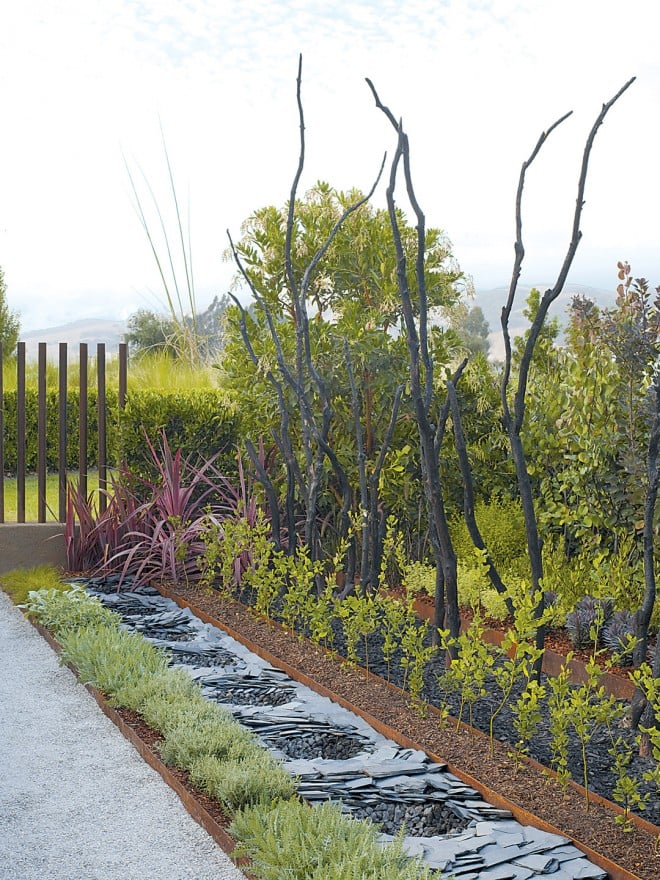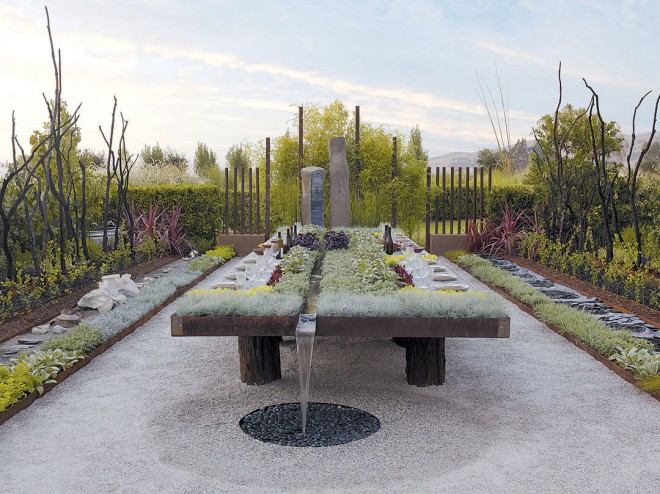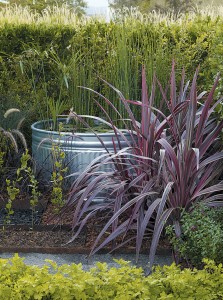
Future Feast in the Garden of Flow/Accumulation

Contributor

I opened my design studio, Sculptural Landscapes, in 1984, after receiving a Masters of Arts degree in sculpture. What began as a design/build practice slowly evolved into a design/project management studio. Monumental sculpture became a major element of my work; I viewed my sculpture and my landscapes as one and inseparable. Attending the 2008 Bioneers Conference dramatically affected my way of thinking, living, creating, and designing. I studied the concept of permaculture and the developing technology for green roofs. My design practice evolved further into one that is committed to deep ecology, using permaculture principals that emphasize soil building, water conservation, plantings that sustain each other, local materials, and a conservation of energy and resources. I worked to find my way in this new world that had become my passion.
Future Feast in the Garden of Flow/ Accumulation was a result of these changes. It was a seminal garden for me—the result of extensive exploration into the meaning of global warming and sustainability.

The concept of flow and accumulation first came to my attention while studying the work of architect Sim Van Der Ryn. Flow is the way of nature; all systems tend to work in cycles, entailing the continual movement of resources and energy. As humans became more concerned about controlling nature, the economic model changed from emphasizing the flow of natural resources to the accumulation of them. Accumulation of monetary wealth, the way of humans, gave rise to the disruption of natural cycles and to such current problems as deforestation and polluted waterways. I firmly believe that the root cause of global warming and unsustainable practices is our focus on accumulation.

Symbol and Significance
In Future Feast, I symbolize some of the results of this disruption of natural cycles: deforestation (charred pieces of wood rising six to eight feet from a lifeless understory of slash); depletion of natural resources (pits of lava rock surrounded by patterns of slate); extinction (fossils and logs turned over to reveal impressions of salamanders no longer alive in a sea of sterile dirt and stones). Elegantly sculptural, the presentation of these symbols is enticing at first glance—until the true meaning becomes apparent: the flow of natural processes has been exploited, choked off, misdirected to create dead-end accumulations
In contrast to these channels of disturbing accumulation are channels of hopeful flow, symbolized by: oak seedlings—hope for the restoration of depleted forests; plants that attract insects, bees, and butterflies (Achillea ‘Coronation Gold’, Lavandula ‘Silver Frost’, Stachys byzantina ‘Big Ears’, and Thymus vulgaris ‘Transparent Yellow’)—hope for an end to species extinction; and plants that free the earth of toxins (Scirpus cernuus)—hope for the rebuilding of soils in areas of pollution and desertification. These planted channels are mounded and appear to overwhelm the bleak channels of accumulation.
The channels of contrasting flow and accumulation are surrounded by plantings of trees and shrubs based on the permaculture guild system. In designing the garden, I needed more information on this system of planting, so I invited Patrick Picard, of Equinox Landscape, to collaborate with me on the project and compose the plantings. [See below for Patrick’s thoughts about Future Feast.]

Table as Centerpiece
In the center of the garden is a further symbol of hope in the form of the Future Feast table. It rests on legs of local, reclaimed redwood and uses the technology of green roofs for its living surface. Sluicing through the table’s center is a runnel, which is part of the irrigation system and is powered by a solar pump, circulating water around the garden. Equally at home on a rooftop, the plants selected for the table include a selection of sedums, grasses (Festuca), and sages (Salvia officinalis). Around each place setting are edibles to be harvested by diners: ‘Simpson’s Elite’ lettuce, ‘Victoria’ lettuce, ‘Bull’s Blood’ heirloom beets, purple-leaf basil, and red chard. The crops would be changed seasonally.
Presiding over the table are two tall basalt stone columnar sculptures, symbolizing ancient wisdom, rising from pools of water. Behind them is a dense planting that acts as a windbreak as well as a consumer of carbon dioxide.
My hope for this garden was to educate and share with people information about a sustainable landscape that offers solutions to the problems we face today. With this installation designed boldly around key concepts of sustainability, we aimed to draw attention to water conservation and catchment, plant selections that build soil and sustain each other, edible landscapes, green-roof technology, and the use of local materials. It was also important to demonstrate that this can be achieved in a contemporary sculptural design, which allowed me to return to the roots of my professional practice while creating a garden for the future.

A Permaculture Approach
After becoming certified in Permaculture Design, I became so convinced of its wisdom that I converted my business from conventional techniques to a more ecological approach, using organic gardening techniques and sustainable construction practices. In 2006, Equinox became a Green Certified Business, further establishing our dedication to the environment.
As an ecological landscape professional, I focus on creating fertility in the soil so that each garden can thrive naturally. Plants are selected to serve multiple functions in order to create a self-sustaining ecosystem. This is one of the big differences between conventional and sustainable landscape design; we no longer have the luxury of choosing plants based only on beauty. Our planet is experiencing a worldwide soil crisis, and it is crucial that we put nutrients back into the soil through our landscape choices.

For Future Feast, Equinox Landscape designer Cynthia Sumner and I selected plants that work in guilds (multi-layered communities, as found in nature) to assist in building the soil. We selected native nitrogen-fixing plants, such as Ceanothus ‘El Dorado’, Western redbud (Cercis occidentalis), and coffeeberry (Rhamnus californica), to take nitrogen from the atmosphere and deposit it back into the soil. We chose herbaceous plants, such as yarrow (Achillea millefolium) and chicory (Cichorium intybus), as “dynamic accumulators,” plants that send their long tap roots deep into the soil to draw up the minerals that other plants need in the soil’s upper layers. We used lamb’s ears (Stachys byzantina ‘Big ears’) for its large, soft leaves that naturally shade the soil and mulch it as they wither and fall. And to create an insectary that would attract beneficial insects, we included plants such as feverfew (Chrysanthemum parthenium) and Salvia ‘Bee’s Bliss’.
Our goal was to create a beautiful contemporary garden where plants contribute to the fertility of the soil, in turn aiding the growth of all of the plants. The challenge for us, as designers, was balancing the repetition of plantings, typical of contemporary gardens, with the biodiversity that is crucial in an ecological garden. For the Future Feast table, we also wanted to demonstrate that edible plants can add beauty as the centerpiece of a garden.
Share:
Social Media
Garden Futurist Podcast
Most Popular
Videos
Topics
Related Posts

Ground Up Science for Greener Cities with Garden Futurist Dr. Alessandro Ossola
Spring 2023 Listen to the Podcast here. Alessandro Ossola is a scientist who gets very excited about the challenge of climate change allowing for an

Readying Urban Forests for Climate Realities with Garden Futurist Dr. Greg McPherson
Winter 2023 Listen to the Podcast here. “Going from the mow and blow to a more horticulturally knowledgeable approach to maintaining the landscape. And that

January Showers Bring February flowers…
Fall 2022 It may not quite have the same ring to it as the old English proverb, but it has a lot more truth to

Low Maintenance Gardens – Better for Pollinators and People
Autumn 2022 “I come out every day. It’s therapy, my meditation.” Janet’s young garden transformed from overgrown, invasive plants to mostly natives. The dailiness of










Responses